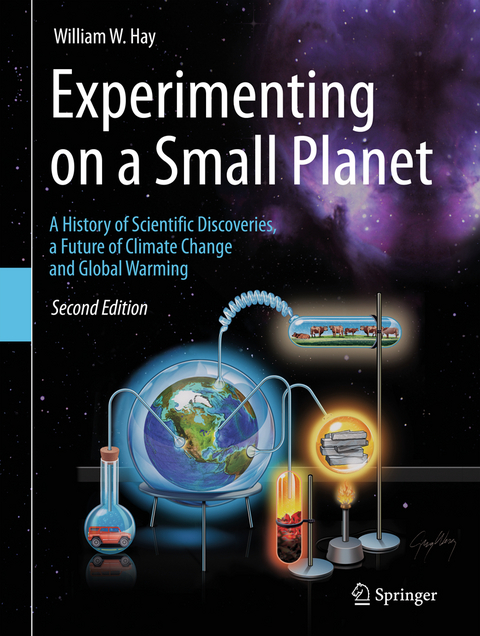
Experimenting on a Small Planet
Springer International Publishing (Verlag)
978-3-319-27402-7 (ISBN)
William W. (Bill) Hay was born October 12, 1934, in Dallas, Texas. He received his B.S. in Biology from Southern Methodist University in 1955, M.S. in Geology from the University of Illinois at Urbana in 1958, and Ph.D. in Geology from Stanford University in 1960. As an undergraduate and graduate student he also studied at Ludwig-Maximillian's University in Munich under Wayne University's "Junior Year in Munich" program, and the University of Zurich as a Fellow of the Swiss Friends of the USA. Afer a year of postdoctoral study at the University of Basel, Switzerland, he began his professional career at the University of Illinois in Urbana in 1960. In 1968 he become a joint Professor of Geology at the University of Illinois and Professor of Marine Geology and Geophysics at the Rosenstiel School of Marine and Atmospheric Sciences (RSMAS) of the University of Miami. He maintained this joint arrangement until 1974. From 1974-76 he served as Chairman of the Division of Marine Geology and Geophysics, and from 1976-1980 as Dean of RSMAS. From 1979 to 1982 he served as President of Joint Oceanographic Institutions, Inc. in Washington, D.C. In 1982 he moved to Boulder, Colorado as Director of the University Museum, and was soon added to the faculty of Geology and CIRES. He resigned as Director of the Museum in 1987, and from 1990 to 1998 was on a half -time appointment at Colorado and half-time as Gastprofessor at GEOMAR, a marine geological research institute attached to Christian-Albrecht's-Universität, Kiel, Germany. In 1991-92 he was an Alexander von Humboldt Senior Research Scientist. In the summer of 1993 he was Gastprofessor in the Sektion Marine Geologie, Institute for Baltic Sea Research in Warnemünde, Germany, and in the fall of the same year F. C. Donders Professor at the Institute of Earth Sciences, University of Utrecht, The Netherlands. In the fall of 1995 and again in 2010 he was Gastprofessor, sponsored by the University of Vienna, in the University's Institut für Paläontologie, Vienna, Austria. During the fall of 1996 he was Gastwissenschaftler, sponsored by the Deutsche Forschungsgemeinschaft, at the Institute for Baltic Sea Research in Warnemünde/Rostock and Gastprofessor at Ernst-Moritz-Arndt University in Greifswald, Germany. During the summer and fall of 1997 he was Gastprofessor at GEOMAR, Christian-Albrecht's-University, Kiel, Germany. He retired from the University of Colorado in 1998 to take on the role of Professor of Paleoceanology full time at GEOMAR. He retired from GEOMAR in June 2002. He is Professor Emeritus at the University of Colorado, and now lives in Estes Park, Colorado. His current special interests are in global paleoclimatic and paleoceanographic modeling; paleoclimate model verification; geological mass balance for the global sedimentation system; modelling tectonics, erosion and sedimentation; topographic and bathymetric effects on climate and oceanography; global plate tectonic reconstructions; global paleogeography; geomaterial fluxes; global carbon cycle. His is author or co-author of more than 260 scientific papers. He has served on the Ocean Sciences Board of the US National Research Council, the Advisory Committee of the Division of Ocean Sciences of the US National Science Foundation, the Board of the Gulf and Caribbean Fisheries Institute, a number of JOIDES (Joint Oceanographic institutions for Deep Earth Sampling) panels and committees, the Scientific Committee on Oceanographic Research (SCOR), and has been a Trustee of the International Oceanographic Foundation. His involvement with ocean drilling goes back to the SUBMAREX (1963), where he was one of the investigators of the paleontology of the cores. He was a reviewer of the LOCO and JOIDES proposals. He served on the JOIDES Gulf Advisory Panel, from1965-74. After moving part time to the Rosenstiel School of the University of Miami he became that institutions representative
Preface.- Introduction.- Intermezzo I. A Slightly Unusual Family.- The Language Of Science.- Intermezzo II. Undergraduate study.- Applying Mathematics to Problems.- Intermezzo III. Graduate study.- Geologic Time.- Intermezzo IV. Graduate study II.- Putting Numbers On Geologic Ages.- Intermezzo V. A Postdoctoral Year in Switzerland - and Europe - I.- Documenting Past Climate Change.- Intermezzo VI. A Postdoctoral Year in Switzerland - and Europe - II.- The Nature Of Energy Received From The Sun - The Analogies With Water Waves And Sound.- Intermezzo VII. New Horizons and the Berlin Wall.- The Nature Of Energy Received From The Sun - Figuring Out What Light Really Is.- The Academic Life.- Exploring The Electromagnetic Spectrum.- Intermezzo IX. Back and Forth through the Iron Curtain.- The Origins Of Climate Science - The Idea Of Energy Balance.- Intermezzo X. Getting used to the East.- The Climate System.- Intermezzo XI. The most memorable summer of my life was 1968.- What'sAt The Bottom Of Alice's Rabbit Hole.- Intermezzo XII. Illinois and Miami.- Energy From The Sun - Long-Term Variations.- Intermezzo XIII The Deep Sea Drilling Project - DSDP.- Solar Variability And Cosmic Rays.- Intermezzo XIV. A History of the Deep Sea Drilling Project and JOIDES.- Albedo.- Intermezzo XV. Internationalization of the Deep Sea Drilling Project.- Air.- Intermezzo XVI. The Cretaceous Puzzle.- HOH - The Keystone Of Earth's Climate.- Intermezzo XVII Becoming a Dean.- The Atmosphere.- Intermezzo XVIII Fund Raising.- Oxygen And Ozone - Products And Protectors of Life.- Intermezzo XIX Building A Building.- Water Vapor - The Major Greenhouse Gas.- Intermezzo XX An Unexpected Detour.- Carbon Dioxide.- Intermezzo XXI Course Correction.- Other Greenhouse Gases.- Intermezzo XXII. Exciting Times.- The Coriolis Force.- Intermezzo XXIII Decision Time.- The Circulation Of Earth's Atmosphere.- Intermezzo XXIV: The Zindani Affair.- The Modern Ocean's General Circulation.- Intermezzo XXV. The Geological Congress in Moscow - 1984.- The Biological Interactions.- Intermezzo XXVI Eagle Plume.- Sea level.- Intermezzo XXVII Second Sabbatical.- Global Climate Change - The (Geologically) Immediate Past.- Intermezzo XXVIII European Odyssey I.- Is There An Analog For The Future Climate?- Intermezzo XXIX European Odyssey II.- The Instrumental Temperature Record.- Intermezzo XXX European Odyssey III.- The Near Future.- Intermezzo XXXI Retirement.- The Distant Future.- Intermezzo XXXII.
Selected by Choice magazine as an Outstanding Academic Title for 2017
"In this title, Hay (emer., Univ. of Colorado) has extraordinarily combined science, art, and humor to provide a thorough, accessible account of the history of climate science. ... The scope and presentation style make this a recommended title for experts interested in learning more outside of their areas of knowledge, students interested in a nontechnical perspective on climate science, or general readers seeking reliable climate science information. ... Summing Up: Highly recommended. All readers." (J. Schoof, Choice, Vol. 54 (5), January, 2017)| Erscheinungsdatum | 14.05.2016 |
|---|---|
| Zusatzinfo | XXXVIII, 819 p. 559 illus., 298 illus. in color. |
| Verlagsort | Cham |
| Sprache | englisch |
| Maße | 210 x 279 mm |
| Themenwelt | Sachbuch/Ratgeber ► Natur / Technik ► Natur / Ökologie |
| Naturwissenschaften ► Biologie ► Ökologie / Naturschutz | |
| Naturwissenschaften ► Geowissenschaften ► Geologie | |
| Naturwissenschaften ► Geowissenschaften ► Meteorologie / Klimatologie | |
| Schlagworte | Climate Change/Climate Change Impacts • Climate change impacts • Climate Science • Earth and Environmental Science • Geology • global change • historical geology • Klimawandel / Klimaveränderung • Paleoclimatology • Popular Science in Nature and Environment • Primer Climate Change • Textbook Climate Change |
| ISBN-10 | 3-319-27402-3 / 3319274023 |
| ISBN-13 | 978-3-319-27402-7 / 9783319274027 |
| Zustand | Neuware |
| Haben Sie eine Frage zum Produkt? |
aus dem Bereich


